RS Aggarwal Solutions: Number System (Exercise 1C) | Mathematics for Class 6 PDF Download
Q. 1. The number of persons who visited the holy shrine of Mata Vaishno Devi during last two consecutive years was 13789509 and 12976498 respectively. How many persons visited the shrine during these two years ?
Ans. Number of persons in the first year = 13789509
Number of persons in the second year = 12976498
Total number of persons in the two years = 13789509 + 12976498
= 26766007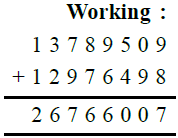
Q.2. Last year, three sugar factories in a town produced 24809565 bags, 18738576 bags and 9564568 bags of sugar respectively. How many bags were produced by all the three factories during last year ?
Ans.
Number of sugar bags in the first factory = 24809565
Number of sugar bags in the second factory = 18738576
Number of sugar bags in the third factory = 9564568
Total number of sugar bags in the three factories
= 24809565 + 18738576 + 9564568
= 53112709 bags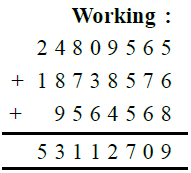
Q.3. A number exceeds 37684955 by 3615045. What is that number ?
Ans. The given number = 37684955
The number which exceeds the given number by 3615045 will be = 37684955 + 3615045
= 41300000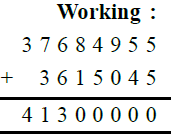
Q. 4. There were three candidates in anelection. They received 687905 votes, 495086 votes and 93756 votes respectively. The number of invalid votes was 13849. If 25467 persons did not vote, find how many votes were registered.
Ans. Number of votes received by the first candidate = 687905
Number of votes received by the second candidate = 495086
Number of votes received by the third candidate = 93756
Number of invalid votes = 13849 Number of persons who did not vote
= 25467
∴ Total number of registered votes
= 687905 + 495086 + 93756 + 13849 + 25467
= 1316063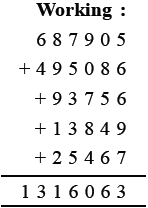
Q.5. A survey conducted on an Indian state shows that 1623546 people have only primary education ; 9768678 people have secondary education ; 6837954 people have higher education and 2684536 people are illiterate. If the number of children below the age of school admission is 698781, find the total population of the state.
Ans.
Number of people who got primary education = 1623546
Number of people who got secondary education = 9768678
Number of people who got higher education = 6837954
Number of illiterate people = 2684536
Number of children below the age of admission = 698781
∴ Total population of the state
= 1623546 + 9768678 + 6837954 + 2684536 + 698781
= 21613495
Q.6. In a particular year a company produced 8765435 bicycles. Next year, the number of bicycles produced was 1378689 more than those produced in the preceding year.
How many bicycles were produced during second year ?
How many bicycles were produced during these two years ?
Ans. In the first year, number of cycles produced = 8765435
In the second year, number of cycles produced = 8765435 + 1378689
= 10144124
The number of bicycles produced in the two years = 8765435 + 10144124
= 18909559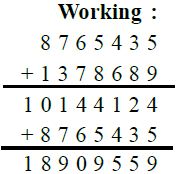
Q.7. The sale receipt of a company during a year was Rs. 20956480. Next year, it
increased by Rs. 6709570. What was the total sale receipt of the company during these two years ?
Ans.
Sale receipt during first year
= Rs. 20956480
∴ Sale receipt during the second year
= Rs. 20956480 + Rs. 6709570
= Rs. 27666050
Total sale receipt during the two years
= Rs. 20956480 + Rs. 27666050
= Rs. 48622530
Q.8. The total population of a city is 28756304. If the number of males is 16987059, find the number of females in the city.
Ans. Total population of a city = 28756304
Number of males = 16987059
∴ Number of females
= 28756304 – 16987059
= 11769245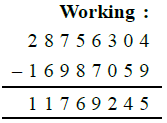
Q.9. By how much is 13246510 larger than 4658642 ?
Ans. The number 13246510 is larger than 4658642
= 13246510 – 4658642
= 8587868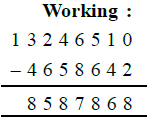
Q.10. By how much is 5643879 smaller than one crore ?
Ans. 5643879 is smaller than one crore
= 10000000 – 5643879
= 4356121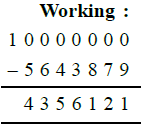
Q.11. What number must be subtracted from 11010101 to get 2635967 ?
Ans.
To get the required number, we should subtract 2635967 from 11010101
= 11010101 – 2635967
= 8374134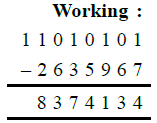
Q.12. The sum of two numbers is 10750308. If one of them is 8967519, what is the other number ?
Ans.
Sum of two numbers = 10750308
First number = 8967519
∴ Second number = 10750308 – 8967519
= 1782789
Q. 13. A man had Rs. 20000000 with him. He spent Rs. 13607085 on buying a school building. How much money is left with him ?
Ans. Total money, a man had = Rs 20000000
Amount spent on buying a school building
= Rs. 13607085
Amount left with him
= Rs. 20000000 – Rs. 13607085
= Rs. 6392915
Q.14. A society needed Rs. 18536000 to buy a property It collected Rs. 7253840 as membership fee, took a loan of Rs. 5675450 from a bank and collected Rs. 2937680 as donation. How much is the society still short of ?
Ans.
The total requirement of a society = Rs.
18536000
Amount of fee collection = Rs. 7253840
Amount of loan taken = Rs. 5675450
Amount of donation = Rs. 2937680
Total amount collected
= Rs. 7253840 + Rs. 5675450
+ Rs. 2937680
= Rs. 15866970
Short amount
= Rs. 18536000 – Rs. 15866970
= Rs. 2669030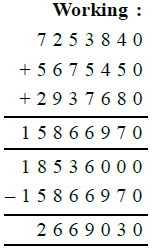
Q.15. A man had Rs. 10672540 with him. He gave Rs. 4836980 to his wife, Rs.
3964790 to his son and the rest to his daughter. How much money was received by the daughter ?
Ans. Total amount a man had = Rs. 10672540
Amount given to his wife = Rs. 4836980
Amount given to his son = Rs 3964790
Total amount given to wife and son
= Rs. 4836980 + Rs 3964790
= Rs. 8801770
Balance amount given to his daughter
= Rs. 10672540 – Rs. 8801770
= Rs. 1870770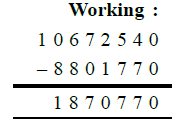
Q.16. The cost of a chair is Rs. 1485. How much will 469 chairs cost ?
Ans. Cost of one chair = Rs. 1485
∴ Cost of 469 chairs = Rs. 1485 × 469
= Rs. 696465
Q.17. How much money was collected from 1786 students of a school for a charity show if each student contributes Rs 625 ?
Sol. Collection from one student = Rs. 625
∴ Collection from 1786 students
= Rs. 1786 × 625
= Rs. 1116250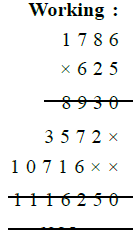
Q.18. A factory produces 6985 screws per day. How many screws will it produce in 358 days ?
Ans.
Number of screws produced in one day
= 6985
∴ Number of screws produced in 358 days
= 6985 × 358 = 2500630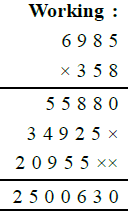
Q.19. Mr. Bhaskar saves Rs. 8756 every month. How much money will he save in 13
years ?
Ans. Number of months in one year = 12
∴ Number of months in 13 years
= 12 × 13 = 156 months
Saving in one month = Rs. 8756
∴ Saving in 156 months
= Rs. 8756 × 156 = Rs. 1365936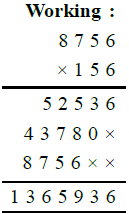
Q.20. A scooter costs Rs. 36725. How much
will 487 scooters cost ?
Ans. Cost of 1 scooter = Rs. 36725
∴ Cost of 487 scooters
= Rs. 36725 × 487 = Rs. 17885075
Q. 21. An aeroplane covers 1485 km in 1 hour. How much distance will it cover in 72 hours ?
Ans.
Distance covered in 1 hour = 1485 km
∴ Distance covered in 72 hours
= 1485 × 72 km = 106920 km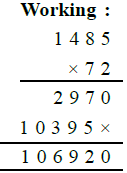
Q.22. The product of two numbers is 13421408.
If one of the numbers is 364, find the other.
Ans. Product of two numbers = 13421408
First number = 364
∴ Second number = 13421408/364
= 36872

Q.23. If 36 flats cost Rs. 68251500, what is
the cost of each flat ?
Ans. Cost of 36 flats = Rs. 68251500
∴ Cost of one flat
= Rs. 68251500/36
= Rs. 1895875
Q.24. The mass of a cylinder filled with gas is 30 kg 250 g and the mass of the empty
cylinder is 14 kg 480 g. How much is the mass of the gas contained in it ?
Ans. Mass of cylinder with gas = 30 kg 250 g and mass of empty cylinder
= 14 kg 480 g
∴ Mass of gas = 30 kg, 250 g – 14 kg, 480 g
= 15 kg, 770 g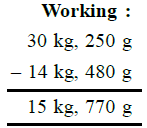
Q.25. From a cloth 5 m long, a piece of length 2 m 85 cm is cut off. What is the length of the remaining piece ?
Ans. Total length of cloth = 5 m
Length of piece cut off = 2 m 85 cm
∴ Length of remaining piece of cloth
= 5 m – 2 m 85 cm
= 2 m 15 cm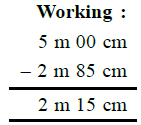
Q.26. In order to make a shirt, a length of 2 m 75 cm of cloth is needed. How much length of the cloth will be required for 16 such shirts ?
Ans.
Cloth required for 1 shirt = 2 m 75 cm
∴ Cloth required for 16 shirts
= 2 m 75 cm × 16
= 44 m
Q. 27. For making 8 trousers of the same size, 14 m 80 cm of cloth is needed. How
much cloth will be required for each such trouser ?
Ans. Total length of cloth for 8 trousers
= 14 m 80 cm
Length of cloth for 1 trouser
= 14 m 80 cm / 8
= 1 m 85 cm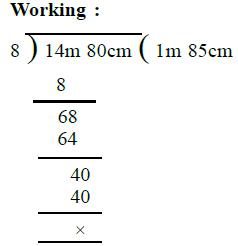
Q.28. The mass of a brick is 2 kg 750 g. What is the total mass of 14 such bricks ?
Ans.
Mass of 1 brick = 2 kg 750 g
∴ Total mass of 14 bricks
= 2 kg 750 g × 14
= 38 kg 500 g
Q.29. The total mass of 8 packets, each of the same size, is 10 kg 600 g. What is the mass of each such packet ?
Ans.
Total mass of 8 packets = 10 kg 600 g
∴ Mass of one packet = 10 kg 600/8
= 1 kg 325 g
Q. 30. A rope of length 10 metres has been divided into 8 pieces of the same length. What is the length of each piece ?
Ans.
Total length of rope = 10 m
No of pieces = 8
Length of each piece = 10 m/8
= 1 m 25 cm
|
48 videos|331 docs|23 tests
|
FAQs on RS Aggarwal Solutions: Number System (Exercise 1C) - Mathematics for Class 6
| 1. What are the different types of numbers in the number system? |  |
| 2. How can we identify a rational number? |  |
| 3. What is the difference between a rational number and an irrational number? |  |
| 4. How can we convert a decimal number into a fraction? |  |
| 5. What is the significance of zero in the number system? |  |
















